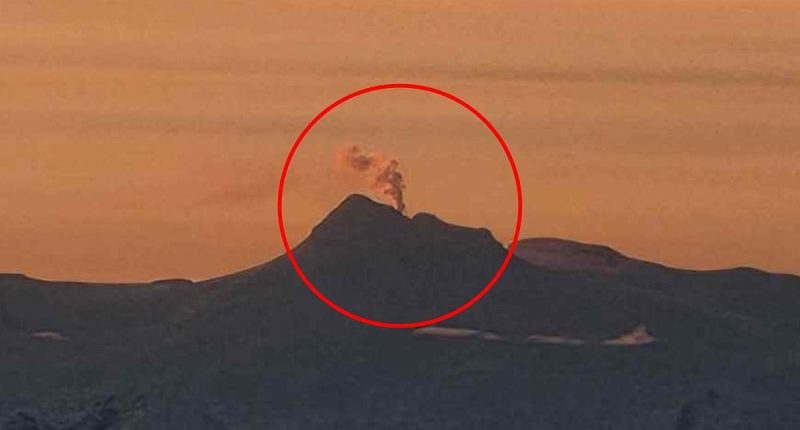Share this @internewscast.com
Multiple earthquakes have hit near Alaska’s Mount Spurr that scientists warn is gearing up for an eruption.
The US Geological Survey (USGS) detected at least a dozen tremors within 30 miles of the volcano.
The seismic activity is caused by magma rising toward the surface, building pressure and causing fractures in the surrounding rock.
A significant earthquake measuring 3.1 in magnitude was detected on Wednesday evening around 30 miles away from Mount Spurr, which was followed by a series of smaller quakes near the volcano’s peak on Thursday.
The Alaska Volcano Observatory (AVO) posted an update regarding the status of Mount Spurr, saying: ‘Unrest continues at Mount Spurr volcano.
‘Small volcanic earthquakes were detected beneath the volcano over the past day.’
An image captured this month reveals the 11,000-foot-high volcano releasing a substantial cloud of steam, probably resulting from magma heating the water below the surface.
Scientists have been closely monitoring this volcano for signs of an eruption, which they say could happen in a matter of weeks or months.

Clusters of earthquakes have occurred near Alaska’s Mount Spurr, with scientists closely monitoring the situation for a potential eruption. A recent photo taken this month shows the 11,000-foot-high volcano releasing a substantial steam cloud, likely due to magma heating underground water.

One of the strongest quakes so far—a magnitude 3.1—was recorded on Wednesday evening, followed by several smaller tremors on Thursday. The orange circles represent earthquakes in the last two hours and yellow for those in the last two days
The AVO has warned that when Mount Spurr erupts, it could unleash powerful explosions sending multiple plumes of ash up to 50,000 feet into the atmosphere.
Each ash-producing event is expected to last three to four hours, with the resulting clouds capable of blanketing Anchorage and nearby areas in thick volcanic dust.
The eruption could also trigger destructive mudflows and fast-moving avalanches of volcanic debris racing down the slopes at over 200 miles per hour.
‘Fortunately, there are no communities within that immediate danger zone,’ Matt Haney, scientist-in-charge at the AVO, told DailyMail.com.
Anchorage, which is home to nearly 300,000 people and located about 78 miles from Mount Spur, has been preparing for the possibility of an eruption by stockpiling food, water and protective gear.
In March, the AVO issued an alert that Mount Spurr could erupt within weeks.
However, activity has since slowed. Ground deformation has decreased, and the ice along the crater’s shoreline remains intact, something that would typically melt if magma were nearing the surface.
‘Although low-level unrest continues, no changes have been observed in the monitoring data to indicate that the volcano is moving closer to an eruption,’ the AVO stated on Wednesday.

Scientists predicted that the eruption will be similar to those in 1953 and 1992 (pictured). These events saw, one or more explosive events, each lasting as long as a few hours, would produce ash clouds carried downwind for hundreds of miles and minor ashfall over southcentral Alaska
While the likelihood of an eruption has decreased since March, seismic activity remains elevated, the Wednesday update noted.
Magma pushing upward creates stress on surrounding rock, fracturing it and triggering earthquakes. This movement is a key indicator of potential volcanic activity.
In the past 24 hours alone, a dozen shallow earthquakes have been recorded near Mount Spurr—another sign that magma may still be shifting beneath the surface.
Haney and his colleagues at the AVO have been closely tracking shallow earthquakes, ground deformation, and gas and steam emissions at Mount Spurr.
If Mount Spurr’s activity continues to ramp up, the next sign of an eruption will be a volcanic tremor, Haney said.
This would be different from the brief, shallow earthquakes this volcano has already been experiencing.
A volcanic tremor is a longer stretch of ongoing shaking that can persist for minutes to days.

Anchorage, which is home to nearly 300,000 people and located about 78 miles from Mount Spur, has been preparing for the possibility of an eruption by stockpiling food, water and protective gear
Scientists predicted that the eruption will be similar to those in 1953 and 1992.
These events saw, ‘one or more explosive events, each lasting as long as a few hours, would produce ash clouds carried downwind for hundreds of miles and minor (up to about ¼ inch) ashfall over southcentral Alaska,’ according to the AVO.
The Municipality of Anchorage reported nearly $2 million in damages, office closures and cleanup costs from the August eruption.
The ash clouds would not just coat Anchorage, but would spark airline chaos.
International hubs such as Ted Stevens Anchorage International Airport (ANC) and potentially Fairbanks International Airport (FAI) would be shut down.
Halting all incoming and departing flights at these airports could have a ripple effect across the country, resulting in widespread delays and cancellations and even disrupting the global supply chain.
Hundreds of planes fly over Anchorage and Fairbanks per day, and it’s not just passenger flights that would be impacted. ANC is the fourth-busiest cargo airport in the world, with more than 8,000 cargo flights passing through each month.
During the 1992 eruption, ANC shut down for 20 hours while the ash cloud hung over Anchorage.
















